教师面试试讲答辩小学英语-词汇what-can-you-do
- 格式:docx
- 大小:55.58 KB
- 文档页数:5
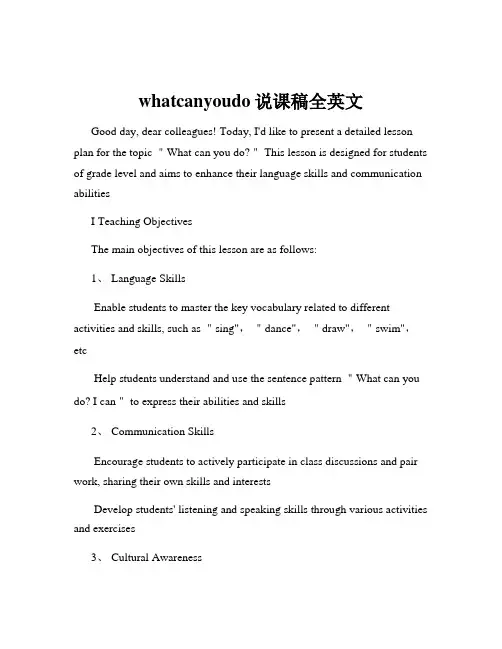
whatcanyoudo说课稿全英文Good day, dear colleagues! Today, I'd like to present a detailed lesson plan for the topic "What can you do?" This lesson is designed for students of grade level and aims to enhance their language skills and communication abilitiesI Teaching ObjectivesThe main objectives of this lesson are as follows:1、 Language SkillsEnable students to master the key vocabulary related to different activities and skills, such as "sing","dance","draw","swim",etcHelp students understand and use the sentence pattern "What can you do? I can" to express their abilities and skills2、 Communication SkillsEncourage students to actively participate in class discussions and pair work, sharing their own skills and interestsDevelop students' listening and speaking skills through various activities and exercises3、 Cultural AwarenessIntroduce students to different hobbies and skills in different cultures, fostering their crosscultural understandingII Teaching Key Points and Difficult Points1、 Key PointsMaster the vocabulary of various activities and skillsUnderstand and use the target sentence pattern correctly2、 Difficult PointsHow to guide students to apply the learned language knowledge in reallife communicationHelping students overcome the pronunciation difficulties of some wordsIII Teaching MethodsTo achieve the teaching objectives and deal with the key and difficult points effectively, the following teaching methods will be adopted:1、 TaskBased Language Teaching Method: Design various tasks to enable students to complete them in the process of learning, thereby improving their language skills2、 Communicative Teaching Method: Encourage students to communicate and interact with each other to enhance their practical language application ability3、 Situational Teaching Method: Create reallife situations to make the learning more vivid and interestingIV Teaching AidsIn this lesson, the following teaching aids will be used:1、 Multimedia resources: Such as pictures, videos, and audio materials to attract students' attention and create a lively classroom atmosphere2、 Flashcards: To help students remember the new vocabulary3、 Whiteboard and markers: For writing key points and explanationsV Teaching Procedures1、 Warmup (5 minutes)Start the class by greeting students and having a short free talk about their weekend activitiesPlay a lively English song related to activities to create a relaxing learning atmosphere and lead in the topic2、 Presentation (10 minutes)Show pictures of different activities on the multimedia, such as singing, dancing, drawing, swimming, etc and teach the corresponding vocabularyUse gestures and actions to help students understand the meaning of the wordsPresent the target sentence pattern "What can you do? I can" through example dialogues and have students repeat3、 Practice (15 minutes)Group Work: Divide students into groups and have them ask and answer the question "What can you do?" using the new vocabulary and sentence patternGame: Play a "memory challenge" game Show a series of pictures of activities for a short time and then ask students to recall and answer what they saw using the target language4、 Production (10 minutes)Have students make a short selfintroduction, including their names and the skills or activities they can doInvite several students to come to the front and share their selfintroductions with the class5、 Consolidation and Extension (5 minutes)Show some pictures of people with different skills from different cultures and briefly introduce them to students to expand their cultural horizonsAssign homework: Ask students to interview their family members or friends about what they can do and write it downVI Blackboard DesignOn the blackboard, the key vocabulary and the target sentence pattern "What can you do? I can" will be written for students to refer to VII Teaching ReflectionAfter the lesson, I will reflect on the teaching process and students' learning situation Analyze the effectiveness of teaching methods and activities, and make improvements for future teaching I will also pay attention to students' individual differences and provide more personalized guidance to help each student make progressThank you for your attention! I believe that through this lesson, students will have a better understanding and application of the language related to expressing abilities and skills Let's look forward to a successful class together!。
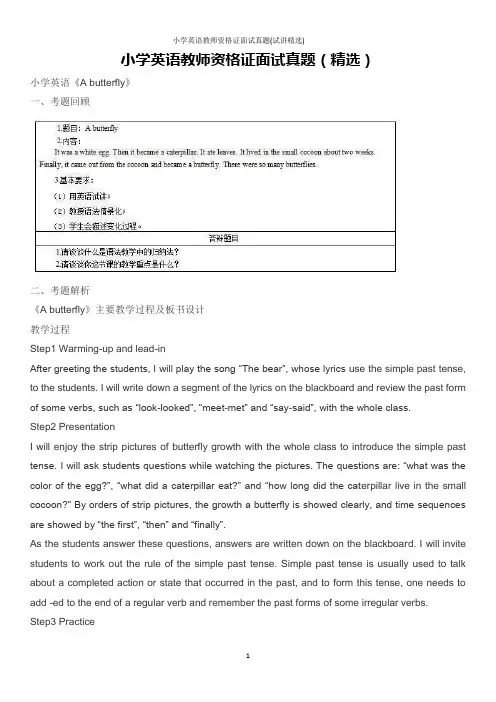
小学英语教师资格证面试真题(精选)小学英语《A butterfly》一、考题回顾二、考题解析《A butterfly》主要教学过程及板书设计教学过程Step1 Warming-up and lead-inAfter greeting the students, I will play the song “The bear”, whose lyrics use the simple past tense, to the students. I will write down a segment of the lyrics on the blackboard and review the past form of some verbs, such as “look-looked”, “meet-met” and “say-said”, with the whole class.Step2 PresentationI will enjoy the strip pictures of butterfly growth with the whole class to introduce the simple past tense. I will ask students questions while watching the pictures. The questions are: “what was the color of the egg?”, “what did a caterpillar eat?” and “how long did the cat erpillar live in the small cocoon?” By orders of strip pictures, the growth a butterfly is showed clearly, and time sequences are showed by “the first”, “then” and “finally”.As the students answer these questions, answers are written down on the blackboard. I will invite students to work out the rule of the simple past tense. Simple past tense is usually used to talk about a completed action or state that occurred in the past, and to form this tense, one needs to add -ed to the end of a regular verb and remember the past forms of some irregular verbs.Step3 Practice1. Conversion task: students are required to converse the following simple present tense simple past tense to better understand the new structure:I usually eat an egg for breakfast.I _____ an egg for breakfast yesterday morning.People often live in houses.John _____ in the small village for about two years.Do you come to your grandma’s twice a week?He _____ to see his grandma last week.There are three people in my family.There _____ many butterflies here 5 years ago.2. Translation task: students are expected to translate the following Chinese the corresponding English.我妹妹早餐吃了一个橙子和一片面包。
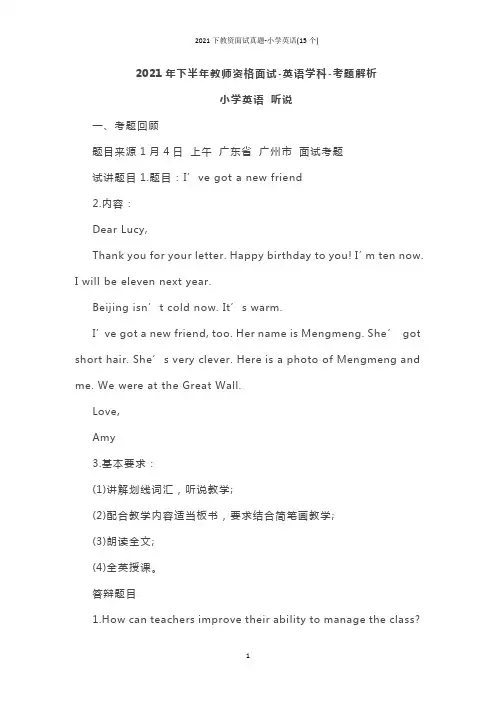
2021年下半年教师资格面试-英语学科-考题解析小学英语听说一、考题回顾题目来源1月4日上午广东省广州市面试考题试讲题目1.题目:I’ve got a new friend2.内容:Dear Lucy,Thank you for your letter. Happy birthday to you! I’m ten now.I will be eleven next year.Beijing isn’t cold now. It’s warm.I’ve got a new friend, too. Her name is Mengmeng. She’got short hair. She’s very clever. Here is a photo of Mengmeng and me. We were at the Great Wall.Love,Amy3.基本要求:(1)讲解划线词汇,听说教学;(2)配合教学内容适当板书,要求结合简笔画教学;(3)朗读全文;(4)全英授课。
答辩题目1.How can teachers improve their ability to manage the class?2.你同意“没有不合格的学生,只有不合格的教师”这句话吗?二、考题解析【教案】I’ve got a new friendTeaching aims:Knowledge aims:Students can read and recognize some key words and phrases, such as “short hair”and “clever”.Students can master the sentence structures “She’s got ......”and “She’s ......”.Ability aim:Students can describe their new friends by using the target words and sentence patterns in their daily life.Emotional aims:Students can enhance their interest of learning English.Students can realize the importance of having friends and loving their friends.Key and difficult points:Key Point: How to describe their new friends by using the target words and sentence patterns.Difficult Point: How to realize the importance of having friends and loving their friends.Teaching procedures:Step 1: Warming-up1. Greetings.2. Invite students to sing a song named Mary Had A Little Lamb. The song is like this:Mary had a little lamb, little lamb, little lamb,Mary had a little lamb, its fleece was white as snow.And everywhere that Mary went, Mary went, Mary went,and everywhere that Mary went, the lamb was sure to go.Then ask students a question, “The little lamb is Mary’s friend. Do you know how to introduce your friend?”Step 2: Pre-listening1. Draw a picture of a famous cartoon character named Curnane.2. Teach the key words and phrases, such as “short hair”and “clever”.Step 3: While-listening1. Extensive listeningRead the passage for students and ask them what the tape is about. Then invite one student to answer. (It’s a letter from Amy to Lucy.)2. Intensive listeningPlay the tape for the second time and ask students several questions:“Who is Amy’s best friend? What’s she like?”“Where were they?”Then ask two volunteers to write his or her answer on the blackboard. And teach the new sentence patterns about how to introduce new friends: “She’s got _______. She’s _______.”Play the tape for the third time and ask students to repe at after the tape.Step 4: Post-listeningLet students work in pairs. Ask students to draw a picture of their new friends and introduce him or her by using the key words and sentence patterns. Five minutes later, invite some students to share and give some comments.Step 5: Summary and HomeworkSummary: Invite a student to be a little teacher and summarize today’s lesson.Homework: Ask students to introduce their new friends to their parents.Blackboard design:Teaching reflection【答辩题目解析】1. How can teachers improve their ability to manage the class?1.老师应如何提高管理班级的能力?【参考答案】The class management can improve teaching efficiency and realize the teaching aims of this class.First, establishing prestige is the foundation. Teachers’prestige can arouse students' positive emotional experience and enable them to keep order. Second, full preparation is the guarantee. Third, controlling teaching process is the key. Teachers should organize the class well and learn to adjust it according to students’response. Fourth, good teacher-student relationship is the essence. A democratic and equal teaching environment can help create a relaxing atmosphere.班级管理可以提高教学效率,实现班级的教学目标。
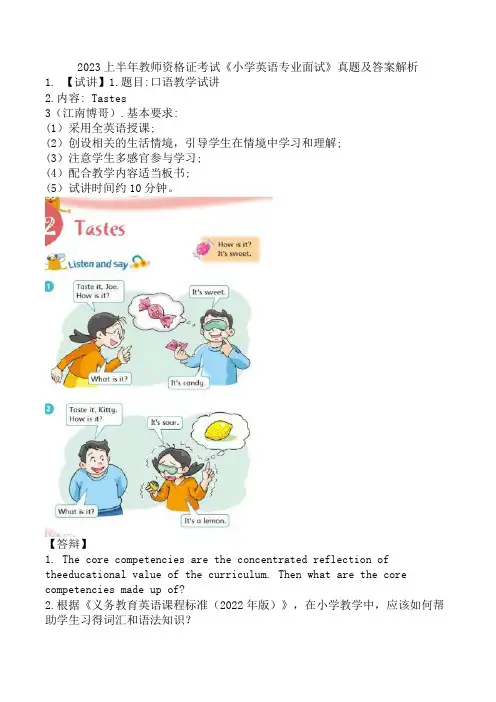
2023上半年教师资格证考试《小学英语专业面试》真题及答案解析1. 【试讲】1.题目:口语教学试讲2.内容: Tastes3(江南博哥).基本要求:(1)采用全英语授课;(2)创设相关的生活情境,引导学生在情境中学习和理解;(3)注意学生多感官参与学习;(4)配合教学内容适当板书;(5)试讲时间约10分钟。
【答辩】1. The core competencies are the concentrated reflection of theeducational value of the curriculum. Then what are the core competencies made up of?2.根据《义务教育英语课程标准(2022年版)》,在小学教学中,应该如何帮助学生习得词汇和语法知识?参考解析:【试讲参考解析】Teaching Procedures:I. Lead-inGreeting.Show students some pictures about different fruit and food and students review the names of them.Ⅱ. Presentation1. Students listen to the tape and confirm their predictions. Get familiar with the topic of tastes.2.Students listen again and learn the sentence patterns "How is it?"and"It's..." to ask and answer the tastes.3.Students read after the tape and imitate the pronunciation and intonation.Ⅲ. Practice1.Students work in pairs to role play the conversation2.Students role play the conversation and then try to make short conversation with the given food on the screen according to the text. IV. ProductionCreate a scene: You are the taste tester in a first-class hotel. You are going to test all the food there. Work in groups to make a short play according to the situation and act it out in the front.V. SummaryStudents summarize the lesson and the teacher makes supplements. VI. HomeworkStudents will share the short play with their parents after school. Blackboard Design:略【答辩及解析】1. The core competencies are the concentrated reflection of the educational value of the curriculum. Then what are the core competencies made up of?【参考答案】The core competencies are the concentrated reflection of the educational value of the curriculum, which consists of the values and attitudes, indispensable qualities and key abilities.The core competencies achieved through the English curriculum include language ability, cultural awareness, thinking capacity and learning ability.2.根据《义务教育英语课程标准(2022年版)》,在小学教学中,应该如何帮助学生习得词汇和语法知识?【参考答案】根据《义务教育英语课程标准(2022年版)》课程内容中的要求,在教学中应创设丰富的语境,在理解和表达活动中帮助学生习得词汇和语法知识。
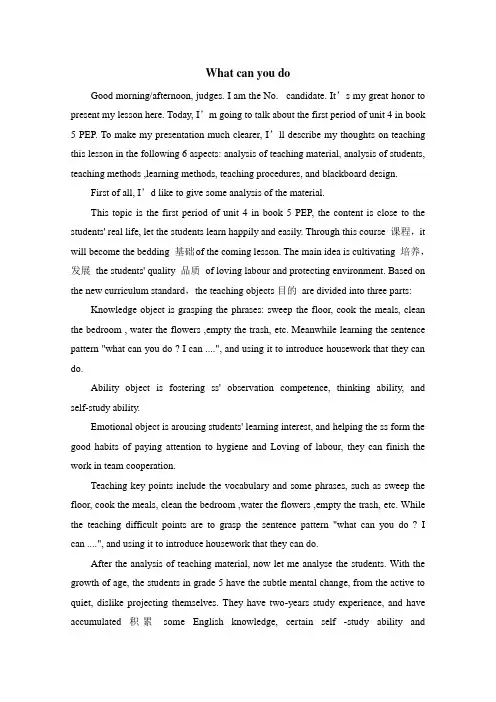
What can you doGood morning/afternoon, judges. I am the No._ candidate. It’s my great honor to present my lesson here. Today, I’m going to talk about the first period of unit 4 in book 5 PEP. To make my presentation much clearer, I’ll describe my thoughts on teaching this lesson in the following 6 aspects: analysis of teaching material, analysis of students, teaching methods ,learning methods, teaching procedures, and blackboard design.First of all, I’d like to give some analysis of the material.This topic is the first period of unit 4 in book 5 PEP, the content is close to the students' real life, let the students learn happily and easily. Through this course 课程,it will become the bedding 基础of the coming lesson. The main idea is cultivating 培养,发展the students' quality 品质of loving labour and protecting environment. Based on the new curriculum standard,the teaching objects目的are divided into three parts: Knowledge object is grasping the phrases: sweep the floor, cook the meals, clean the bedroom , water the flowers ,empty the trash, etc. Meanwhile learning the sentence pattern "what can you do ? I can ....", and using it to introduce housework that they can do.Ability object is fostering ss' observation competence, thinking ability, and self-study ability.Emotional object is arousing students' learning interest, and helping the ss form the good habits of paying attention to hygiene and Loving of labour, they can finish the work in team cooperation.Teaching key points include the vocabulary and some phrases, such as sweep the floor, cook the meals, clean the bedroom ,water the flowers ,empty the trash, etc. While the teaching difficult points are to grasp the sentence pattern "what can you do ? I can ....", and using it to introduce housework that they can do.After the analysis of teaching material, now let me analyse the students. With the growth of age, the students in grade 5 have the subtle mental change, from the active to quiet, dislike projecting themselves. They have two-years study experience, and have accumulated积累some English knowledge, certain self -study ability andcomprehensive综合的usage ability. They have get in touch with some words and can express the things they can do , which provide提供the foundation 基础for this lesson .According to the students physical and physiological characteristics,I will adopt task-based language teaching method, TPR method and the situational approach to improve the students enthusiasm,design a variety of activities , make the students learn to play and play to learn .The students will take part in the activities and finish the tasks cooperatively. They will use the language in a relax, democracy, and harmonious atmosphere .In order to finish my teaching, I will use the tape recorder, multimedia, and pictures as the teaching aids .Now it comes to the the most important part —teaching procedures, it including the following steps:Step 1: warm upI use the VCD to play the content "let's do "in unit 1 of book 4, ss will say and do as the chant, the aim is revising the verbs phrases by listening, speaking, and doing , attracting the ss' attention concentrate to the class .Step 2 :previewI use the VCD to play the part "let's chant "in unit 4 book 5 , all students read after the recorder ,then sing it in group ,let the ss get in touch with the sentence pattern "what can you do ? I can ..." ,and enter in the next part naturally .Step 3:presentationUsing the multimedia to create a real situation, present a dirty and littery classroom ,I will do a individual activity,look at the screen ,ask and answer .I will ask the students "what can you do ?" ss answer the question "I can ..."Then the ss do pair work activity, play a new chant that is about the housework, two ss cooperate to ask and answer .Thus students can use the language into the actual life .Group activity,students watch the chant again and discuss in group what they can hear ,they can play the main role in self-study .Next ,I do actions ,the students look and guess ,after that find out the word card and read for us ,in this way ,ss' initiative and enthusiasm can be mobilized and their self -confidence will be enhanced .I assign a task ,let the students find out the rule of learning ,form a good habit ,have cooperative ability and consciousness . Students discuss in group how to remember the new words well .Step 4 practiseTask 1 Play a game:"snowball" divide the whole students into four groups ,accumulate the phrases and hold a competition in class .Task 2 make a survey .by the mean of investigation , realize the theory of "learning by doing ".students do a survey in groups ,then report the result .Task 3 make a dialogue in group .I will show a scene in the screen ,students make a dialogue and act it out .Step 5 consolidationAt last ,to cultivate the ss' communicative ability in English .I will show the students some word cards and sentence cards ,let them make up a situational dialogue,act the dialogue in role .Step 6 homeworkReport the result to their parents using the sentence pattern and phrases .Finally ,I will talk about my blackboard design,write the key phrases and sentences on the blackboard, in order to let the students know the important points and remember them.Unit 4 What can you do What can you do ?I can ..... sweep the floorcook the mealsclean the bedroomwater the flowersempty the trash。
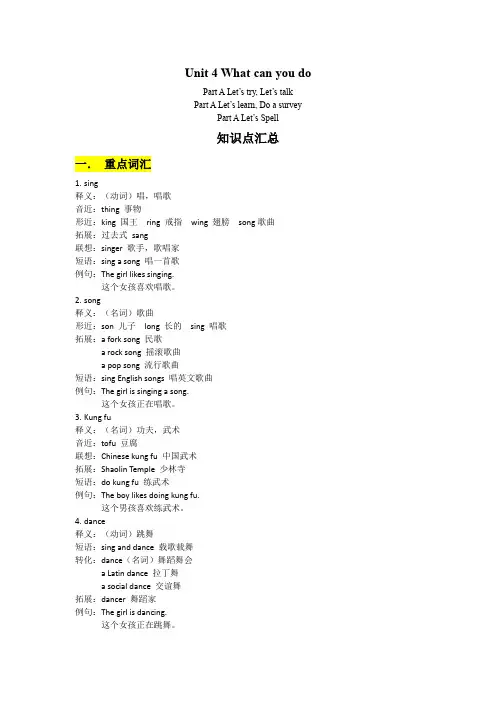
Unit 4 What can you doPart A Let’s try, Let’s talkPart A Let’s learn, Do a surveyPart A Let’s Spell知识点汇总一.重点词汇1.sing释义:(动词)唱,唱歌音近:thing 事物形近:king 国王ring 戒指wing 翅膀song歌曲拓展:过去式sang联想:singer 歌手,歌唱家短语:sing a song 唱一首歌例句:The girl likes singing.这个女孩喜欢唱歌。
2.song释义:(名词)歌曲形近:son 儿子long 长的sing 唱歌拓展:a fork song 民歌a rock song 摇滚歌曲a pop song 流行歌曲短语:sing English songs 唱英文歌曲例句:The girl is singing a song.这个女孩正在唱歌。
3.Kung fu释义:(名词)功夫,武术音近:tofu 豆腐联想:Chinese kung fu 中国武术拓展:Shaolin Temple 少林寺短语:do kung fu 练武术例句:The boy likes doing kung fu.这个男孩喜欢练武术。
4.dance释义:(动词)跳舞短语:sing and dance 载歌载舞转化:dance(名词)舞蹈舞会a Latin dance 拉丁舞a social dance 交谊舞拓展:dancer 舞蹈家例句:The girl is dancing.这个女孩正在跳舞。
5.draw释义:(动词)画义近:paint(用颜料)画联想:painter 画家拓展:过去式drew短语:draw pictures 画画例句:Let’s draw pictures.我们画画吧。
6.we’ll=we will释义:我们将要联想:I’ll=I will 我将要注意:will是情态动词,后接动词原形例句:We’ll ride a horse tomorrow.明天我们将要去骑马。
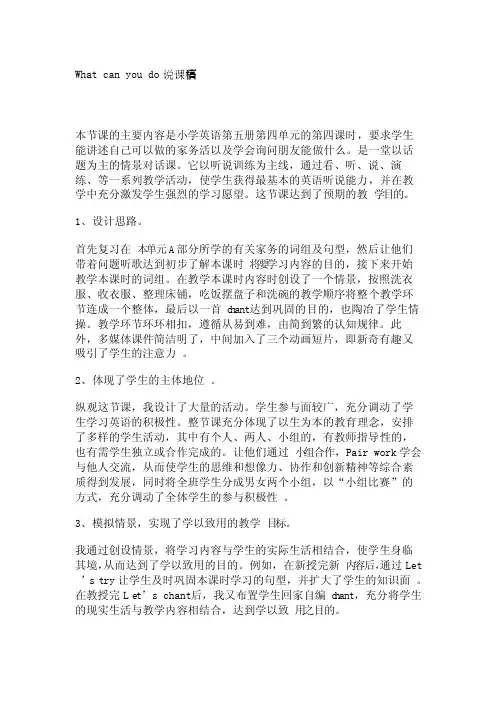
What can you do说课稿本节课的主要内容是小学英语第五册第四单元的第四课时,要求学生能讲述自己可以做的家务活以及学会询问朋友能做什么。
是一堂以话题为主的情景对话课。
它以听说训练为主线,通过看、听、说、演练、等一系列教学活动,使学生获得最基本的英语听说能力,并在教学中充分激发学生强烈的学习愿望。
这节课达到了预期的教学目的。
1、设计思路。
首先复习在本单元A部分所学的有关家务的词组及句型,然后让他们带着问题听歌达到初步了解本课时将要学习内容的目的,接下来开始教学本课时的词组。
在教学本课时内容时创设了一个情景,按照洗衣服、收衣服、整理床铺,吃饭摆盘子和洗碗的教学顺序将整个教学环节连成一个整体,最后以一首c hant达到巩固的目的,也陶冶了学生情操。
教学环节环环相扣,遵循从易到难,由简到繁的认知规律。
此外,多媒体课件简洁明了,中间加入了三个动画短片,即新奇有趣又吸引了学生的注意力。
2、体现了学生的主体地位。
纵观这节课,我设计了大量的活动。
学生参与面较广,充分调动了学生学习英语的积极性。
整节课充分体现了以生为本的教育理念,安排了多样的学生活动,其中有个人、两人、小组的,有教师指导性的,也有需学生独立或合作完成的。
让他们通过小组合作,Pair work学会与他人交流,从而使学生的思维和想像力、协作和创新精神等综合素质得到发展,同时将全班学生分成男女两个小组,以“小组比赛”的方式,充分调动了全体学生的参与积极性。
3、模拟情景,实现了学以致用的教学目标。
我通过创设情景,将学习内容与学生的实际生活相结合,使学生身临其境,从而达到了学以致用的目的。
例如,在新授完新内容后,通过Let ’s try让学生及时巩固本课时学习的句型,并扩大了学生的知识面。
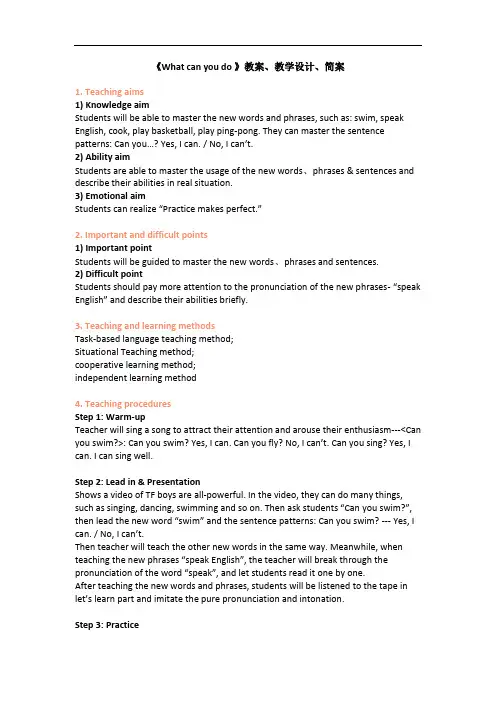
《What can you do 》教案、教学设计、简案1. Teaching aims1) Knowledge aimStudents will be able to master the new words and phrases, such as: swim, speak English, cook, play basketball, play ping-pong. They can master the sentence patterns: Can you…? Yes, I can./ No, I can’t.2) Ability aimStudents are able to master the usage of the new words、phrases & sentences and describe their abilities in real situation.3) Emotional aimStudents can realize “Practice makes perfect.”2. Important and difficult points1) Important pointStudents will be guided to master the new words、phrases and sentences.2) Difficult pointStudents should pay more attention to the pronunciation of the new phrases- “speak English” and describe their abilities briefly.3. Teaching and learning methodsTask-based language teaching method;Situational Teaching method;cooperative learning method;independent learning method4. Teaching proceduresStep 1: Warm-upTeacher will sing a song to attract their attention and arouse their enthusiasm---<Can you swim?>: Can you swim? Yes, I can. Can you fly? No, I can’t. Can you sing? Yes, I can. I can sing well.Step 2: Lead in & PresentationShows a video of TF boys are all-powerful. In the video, they can do many things, such as singing, dancing, swimming and so on. Then ask students “Can you swim?”, then lead the new word “swim” and the sentence patterns: Can you swim? --- Yes, I can. / No, I can’t.Then teacher will teach the other new words in the same way. Meanwhile, when teaching the new phrases “speak English”, the teacher will break through the pronunciation of the word “speak”, and let students read it one by one.After teaching the new words and phrases, students will be listened to the tape in let’s learn part and imitate the pure pro nunciation and intonation.Step 3: Practice1) Bomb Game. Teacher will play a game “Bomb Game” to consolidate the new words and phrases. For example: Suppose “cook” is a bomb, if teacher reads “cook”, students should keep silent. If teacher reads the other words and phrases, students should follow the teacher to read them out.2) Pair-work. After this game, the teacher will ask students work in pairs to use the key words、phrases and key sentence patterns to ask and answer, and choose some volunteers to show. Then give the best pair reward and courage the others.Step 4: ProductionGroup work. Teacher will set a situation---suppose our school will hold an“All-Powerful Competition”, and choose the best one to be the “All-Powerful Star”. Students will make a new conversation by using the words、phrases and the sentences patterns they have learnt: Can you…?Yes, I can. / No, I can’t. 4 students will be one group, and then give the best group reward.Step 5: Summary and homeworkTeacher leads students to summarize what they have learned in this class, and lead them realize “Practice makes perfect.”Homework: Introduce what can you do & you can’t do to your parents.5. Blackboard designWhat can you do?--- Can you swim/ cook?speak Englishplay basketballplay ping-pong--- Yes, I can. / No, I can’t.。
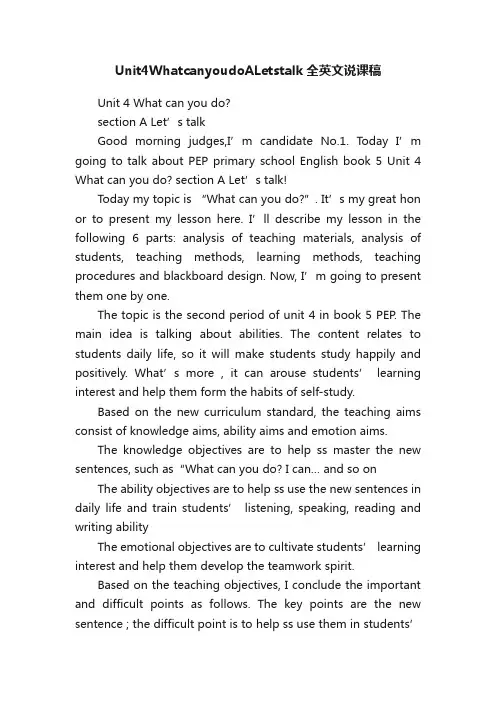
Unit4WhatcanyoudoALetstalk全英文说课稿Unit 4 What can you do?section A Let’s talkGood morning judges,I’m candidate No.1. Today I’m going to talk about PEP primary school English book 5 Unit 4 What can you do? section A Let’s talk!Today my topic is “What can you do?”. It’s my great hon or to present my lesson here. I’ll describe my lesson in the following 6 parts: analysis of teaching materials, analysis of students, teaching methods, learning methods, teaching procedures and blackboard design. Now, I’m going to present them one by one.The topic is the second period of unit 4 in book 5 PEP. The main idea is talking about abilities. The content relates to students daily life, so it will make students study happily and positively. What’s more , it can arouse students’ learning interest and help them form the habits of self-study.Based on the new curriculum standard, the teaching aims consist of knowledge aims, ability aims and emotion aims.The knowledge objectives are to help ss master the new sentences, such as“What can you do? I can… and so on The ability objectives are to help ss use the new sentences in daily life and train students’ listening, speaking, reading and writing abilityThe emotional objectives are to cultivate students’ learning interest and help them develop the teamwork spirit.Based on the teaching objectives, I conclude the important and difficult points as follows. The key points are the new sentence ; the difficult po int is to help ss use them in students’daily life.After the analysis of teaching materials, now, let me analysis the students, with the growth of age, students in grade 5 have studied English more than two years and they’ve had certain skills in English, They are all like acting and showing in the class.According to the new curriculum standard and situation of students in this class, I will adopt TPR method, communicative teaching method and situational language teaching , I will design some activities, make the students learn to play and play to learn.As to learning methods, the students can study English independently and cooperatively. For example they can make preparation before class. During the class, they can study by cooperative learning through the discussion in pair or group .then they can put the new knowledge into communication gradually.OK, so much for the teaching methods and learning methods. Next comes my most important part, the teaching procedures. Based on students' characteristics, in this class ,I will stick to the theory" students are the masters in the class, while teachers act as the directors" "Learning by doing, learning by using" "Learn to play, play to learn ",I design the following procedures.Step1: Warm-up and Leading inIn this step I will show a chant first, lets the student feel relax in the English class, let students to review the content we learned before, at the same time to prepare for the new lesson.Then show some pictures to review the content we learned before, On one hand, it can relax ss, on the other hand, it can review the language.Step2 presentation:In this step, I will show some abilities , leads to the key sentences: First I will do some kungfu,then lead in the key sentences:” I can do some kungfu” Teach the sentence .Ask the students to read it after teather for three times.Next,I will sing an English song,in this way,I can lead the key sentence;I can sing English songs. Teach it and ask ss to read it , I will write the key sentences in the blackboard.To practice the sentences.ThenThen the teacher draw a picture and ask “I can draw pictures, what can you do?:Thus lead to the key question, What can you do? Read the sentences.I will write the key sentence , such as“what can you do? ,I can 。
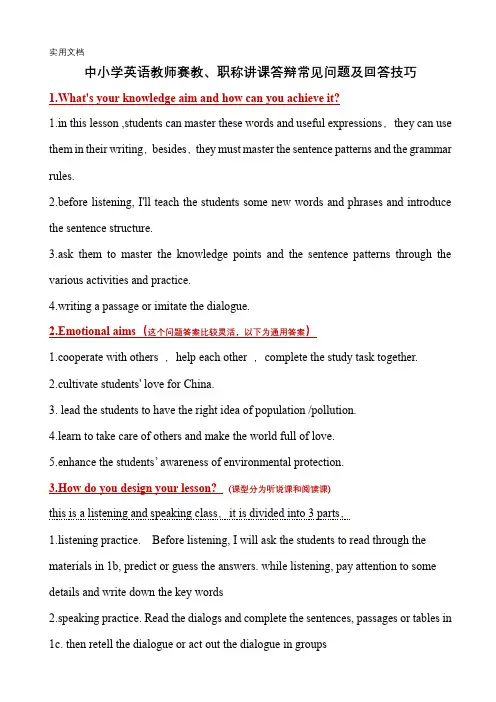
中小学英语教师赛教、职称讲课答辩常见问题及回答技巧1.What's your knowledge aim and how can you achieve it?1.in this lesson ,students can master these words and useful expressions,they can use them in their writing,besides,they must master the sentence patterns and the grammar rules.2.before listening, I'll teach the students some new words and phrases and introduce the sentence structure.3.ask them to master the knowledge points and the sentence patterns through the various activities and practice.4.writing a passage or imitate the dialogue.2.Emotional aims(这个问题答案比较灵活,以下为通用答案)1.cooperate with others ,help each other ,complete the study task together.2.cultivate students' love for China.3. lead the students to have the right idea of population /pollution.4.learn to take care of others and make the world full of love.5.enhance the students’ awareness of environmental protection.3.How do you design your lesson? (课型分为听说课和阅读课)this is a listening and speaking class,it is divided into 3 parts,1.listening practice. Before listening, I will ask the students to read through the materials in 1b, predict or guess the answers. while listening, pay attention to some details and write down the key words2.speaking practice. Read the dialogs and complete the sentences, passages or tables in 1c. then retell the dialogue or act out the dialogue in groups3.make up conversations according to the pictures.this is a reading class which is divided into 3 parts1.pre- reading, I will give the students some questions,let them guess the meaning of the new words. predict which statements are true,,2.while reading. Complete to the table, blanks according to the passages,get the main idea of the article,or find the topic sentence, present key words of the article3.post reading. Retell the passage according to the keywords,tables or diagram or guide the students to write a related passage.4.What is your teaching difficult point?这个问题答案比较灵活,以下为通用答案)1. students are new to this topic so it's difficult for them to understand the passage.2.the students have difficulty in telling the differences between XXX and XXX3.it's difficult for the students to learn the rules of the grammar.5.Teaching reflection(教学反思)I have carefully designed the activities for this class, there are some advantages in my class. First, most of the students showed interest in this lesson, So they can take an active part in this class and can finish most of the tasks in given time. Second, with my help, the students are able to cooperate with others and think independently. However,I think I should leave enough time for the students to practice.6.How do you help students get the general idea of a reading passage?e the pictures, videos and some key words to help students understand the passage2.ask the students to find the topic sentence of the passage3.write or choose the best title of the passage7.How do you improve the student's reading ability?1.help the students develop a good habit of the English learning2.choose the interesting and the suitable materials, such as short stories, fairy tales and so on.3.teach the students some reading skills and enlarge their vocabularyI am sure they will make great progress as long as they stick to reading.8. What is skim, what is scan?1.the purpose of skimming is to get the main idea of the passage.2.the purpose of scanning is to get some details, you can only read the useful parts. 9.Can you tell me the teachers’ role in class activities?1.teachers play the role of designers,they design the class activities and set up the tasks.2.as an organizer,the teacher organize students how to behave in the activities.3.as a guide,the teacher can arouse the students’ interest to complete the class activities.10.How do you treat the slow-learned student?1.I should the encourage them often and make them feel good about themselves2.I should spend more time helping them with their English.3. I should help them develop a good habit of learning.11.Can you tell me some ways of leading in a new lesson?The leading-in part plays an important part on the new lesson. There are many ways of leading-in, such as a free talk about the topic, some pictures about the new lesson, reviewing the last lesson, playing a game and so on.No matter what kind of methods we use, we should arouse the students interest and link them closely to the new lesson.12.Blackboard function1. present the difficult points or key points during the whole class.2.outline the whole teaching procedure with tables,diagrams and so on.In a word,the blackboard design is used to make the class more efficient. and help the students understand the class better.13.H ow are you going to keep your lesson interesting?1.I will design my lesson carefully and I can choose some interesting materials, such as stories, poems, fairy tales, riddles, English songs and so on.2.I will use some activities during my class,such as group work,pair work and independent work, so that the students can take an active part in the class.3.I will try my best to teach them some study skills, so that they can get a sense of achievement.14.How do you assign the homework?1. I can divide the students into different levels.2.the homework should be linked to their interest.3.pay attention to the creativity and variety.15.Can you tell me the differences between come true and realize?For example,I hope we can realize our dreams.I hope our dreams will come true.the subject of realize is somebody,the subject of come true is the dream.16.Can you tell the differences between the simple past tense and the present perfect tense?1.simple past tense refers to the action or condition that has taken place in the past,it often goes with these phrases, such as last week, yesterday, 3 days ago ,in the past and so on.2.the present perfect tense focus on the effect of the past action on the present. it often goes with these phrases,such as so far, recently, for, since and so on.17.What books would you recommend to your students?I will choose The Adventures of Tom Sawyer.This book was written by a famous American writer Mark Twain. The characters of the book are very lovely and clever. It has wonderful plots and the words are easy to understand, too. I think the students will like it very much.18.What will you do if a student broke the rules in your class?1.I will tell the students what he did is not right.2. I will help him find out the reasons.3. I will try my best to discover advantages of the student and praise him often.19.What's a good teacher of English learning?1. love your students and be patient with them.2.have a wide knowledge of English, and go on learning all the time.3.be good at finding the advantages of every student and use the proper way to praise them.4. raise the student's interest and develop a good habit in learning20.How to improve the student's interest in listening?Listening plays an important part in our examination, in order to improve the students’ listening ability,I will do as the following steps:1.as an English teacher, I will speak English as much as possible2.I will encourage the students to see English movies, listen to English songs. or English news.3.I will choose some interesting listening materials, to arouse the students' interest and teach them some listening skills.4.help them to develop a good habit21.How do you improve the student's reading ability?1.help the students develop a good habit of the English learning2.choose the interesting and the suitable materials, such as short stories, fairy tales and so on.3.teach the students some reading skills and enlarge their vocabularyI am sure they will make great progress as long as they stick to reading.22..How do you teach new words?1. teach students how to read that words to make them have a correct pronunciation2. teach the new words in sentences or passages and make them guess the meaning first. sometimes I can use pictures, gestures or games to help students understand3. I will give students some examples and then ask them to make sentences after the models4.ask the students to compare the new words with the similar ones, let them know about the word formation.。
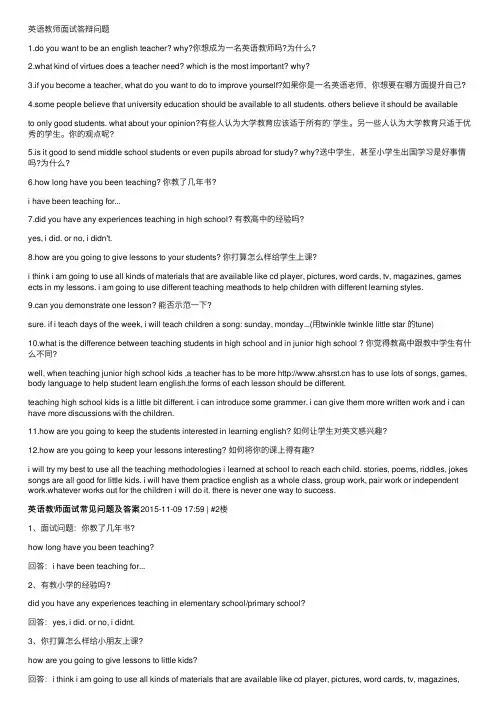
英语教师⾯试答辩问题1.do you want to be an english teacher? why?你想成为⼀名英语教师吗?为什么?2.what kind of virtues does a teacher need? which is the most important? why?3.if you become a teacher, what do you want to do to improve yourself?如果你是⼀名英语⽼师,你想要在哪⽅⾯提升⾃⼰?4.some people believe that university education should be available to all students. others believe it should be availableto only good students. what about your opinion?有些⼈认为⼤学教育应该适于所有的`学⽣。
另⼀些⼈认为⼤学教育只适于优秀的学⽣。
你的观点呢?5.is it good to send middle school students or even pupils abroad for study? why?送中学⽣,甚⾄⼩学⽣出国学习是好事情吗?为什么?6.how long have you been teaching? 你教了⼏年书?i have been teaching for...7.did you have any experiences teaching in high school? 有教⾼中的经验吗?yes, i did. or no, i didn't.8.how are you going to give lessons to your students? 你打算怎么样给学⽣上课?i think i am going to use all kinds of materials that are available like cd player, pictures, word cards, tv, magazines, games ects in my lessons. i am going to use different teaching meathods to help children with different learning styles.9.can you demonstrate one lesson? 能否⽰范⼀下?sure. if i teach days of the week, i will teach children a song: sunday, monday...(⽤twinkle twinkle little star 的tune)10.what is the difference between teaching students in high school and in junior high school ? 你觉得教⾼中跟教中学⽣有什么不同?well, when teaching junior high school kids ,a teacher has to be more has to use lots of songs, games, body language to help student learn english.the forms of each lesson should be different.teaching high school kids is a little bit different. i can introduce some grammer. i can give them more written work and i can have more discussions with the children.11.how are you going to keep the students interested in learning english? 如何让学⽣对英⽂感兴趣?12.how are you going to keep your lessons interesting? 如何将你的课上得有趣?i will try my best to use all the teaching methodologies i learned at school to reach each child. stories, poems, riddles, jokes songs are all good for little kids. i will have them practice english as a whole class, group work, pair work or independent work.whatever works out for the children i will do it. there is never one way to success.英语教师⾯试常见问题及答案2015-11-09 17:59 | #2楼1、⾯试问题:你教了⼏年书?how long have you been teaching?回答:i have been teaching for...2、有教⼩学的经验吗?did you have any experiences teaching in elementary school/primary school?回答:yes, i did. or no, i didnt.3、你打算怎么样给⼩朋友上课?how are you going to give lessons to little kids?回答:i think i am going to use all kinds of materials that are available like cd player, pictures, word cards, tv, magazines,games ects in my lessons. i am going to use different teaching meathods to help children with different learning styles.4、能否⽰范⼀下?can you demonstrate one lesson?回答:sure. if i teach days of the week, i will teach children a song: sunday, monday...(⽤twinkle twinkle little star 的tune) 5、你觉得教⼩学⽣跟教中学⽣有什么不同?what is the difference between teaching elementary school children and the junior high school children?回答:well, when teaching little kids a teacher has to be more has to use lots of songs, games, body language to help student learn english.the forms of each lesson should be different.teaching junior high school kids is a little bit different. i can introduce some grammer. i can give them more written work and i can have more discussions with the children.【英语教师⾯试答辩问题】。
小学英语说课稿《What can you do》Unit 4 What can you doLet’s learnGood morning, my dear judges. I'm the first competitor. It's my great honor to have this opportunity to talk about my teaching ideas. Today my topic is “Unit 4 What can you do?” I am going to introduce my lesson from the following aspects:1 Analysis of teaching materialsThe unit is from PEP English book, the first semester of grade 5. The topic of this unit is about some recreational and sports activities and what students can do. Through this part, students will learn some new words and important sentence structures “What can you do? I can…”, which can make students to share their hobbies with others, so that their speaking and listening abilities can be improved.2 Analysis of studentsStudents in Grade 5 are active, curious to new interesting things. After learning English for 2 years, they haveaccumulated some basic English knowledge, but most of them are not confident to express themselves, so I will arrange more interesting activities in order to provide them more chances to speak in English.3 Analysis of teaching aimsAccording to the New Curriculum Standard in English and the analysis of teaching materials and students, I set the following teaching aims:(1) Knowledge aims:Students can spell and understand the meaning of the new vocabularies and phrases of different activities. Students can master the new sentence patterns “what can you do” and “I can sing English songs”.(2) Ability aims:Students can use the vocabularies and sentence patterns to talk about their abilities fluently.(3) Emotional aims:Students will cultivate more hobbies in their spare time.Students will enjoy communicating with each other in English.4 Analysis of teaching key points and difficult points The key points are to master new words and phrases: dance, sing English songs, do kung fu, draw cartoons, play the pipa as well as the sentence pattern “What can you do? I can…”The difficult point is how to speak English freely and naturally in their daily life by using the words and sentences.5 Analysis of teaching methods and learning methodsI’ll mainly use “Task-based teaching method” , “Total physical response approach” and “Situational teaching method” .I think only by using various methods can let students focus on the class. I will do my best to diversify the forms of the teaching activity such as pair work and group work and to make sure that the students are the real masters of the class.6 Analysis of teaching aidsIn order to attract students’ attention, I will prepare multi-media and pictures.7 Analysis of teaching proceduresNow, let’s move to the most important part of this lesson: the analysis of the teaching procedures. This part is divided into 4 stages, that is, Warming-up, presentation and practice, production and summary & homework.Step 1 Warming-upIn this stage, I will greet students as usual to create English learning atmosphere for the students. Let students enjoy a chant named “what can you do?”.This rhyme is like that “Dog, dog, what can you do? I can run after you. Panda, panda, what can you do? I can eat so much bamboo. Mike, mike, what can you do? I can draw animals in the zoo!” l will remind students to pay more attention to some words, run, eat bamboo and draw animals. And if it is necessary, I will do some acts or paraphrasing to explain the words. Rhyme is a good way to attract students attention to this class as well as it can lay a good foundation for the following steps.Step 2 Presentation and Practice(1) Words learning and practiceTell students that Mrs White’s class will hold an English party next week and use a question “do you want to know what the students in her class can do for this party?”to lead to the pictures. Then show some pictures in the book and ask them “What can the students in the pictures do? ”. Through this, students can learn the new words primarily. When asking them, I will pay attention to students’ reaction and the interaction among them. For example, when talking about “do kung fu”,I will ask them “W ho can do kung fu in our class?”, and invite Tom to make a performance. Tell them that it is a good exercise to keep fit, if they are interested, they can learn from him. This process can realize the emotional aims of cultivating more hobbies in daily life. Then ask them to read the words one by one after the teacher in different ways.After teaching these words and phrases, teacher will play a game named act and say game with students to practice all the vocabularies. Total physical response approach is adopted in this stage. Doing actions is a good way for theprimary students to have a better understanding of the meaning of the words and to remember them better.(2) Sentence learning and practiceIn this stage,I will teach them about when to use the target language in a direct way, in order to make sure they can use them correctly in the following practice. Teach students if they want to ask others’ abilities or tell others about their own abilities, they can use the sentence “What can you do?” and “I can…”.Next activity is to ask students to make conversations with their partners by using the new phrases and sentences. Then use the rhyme that we’ve used in the warming-up to play their conversations. Using the above rhyme can maintain their interests.Step 3 ProductionIn this process, I will let students do group work. Group work is a good way to develop their cooperation and communication abilities. Divide students into several groups and ask them to make a survey about what their group members can do and finish the chart on the screen. Afterthey finish, ask their representatives to make a report by using the new sentence patterns. By doing this, I want students to apply the target language into the real situation. And classmates can strengthen their understandings and friendship with each other.Step 4 Summary and homeworkStudents are the subject of the class, so I will try to provide more chances for them to take part in. So I will invite someone to be the teacher and lead us to read the phrases. At the end of class, I’ll also leave them a task, that is, to do a survey on what your friends can do and share your findings next time. This can consolidate what we have learned in the lesson.8 Analysis of blackboard design板书设计(Purpose: This could make clear the important information of this lesson and help students to make the notes.)小学英语教案《What can you do》Unit 4 What can you doLet’s learnTeaching aims:Knowledge aims:1. Students can spell and understand the meaning of the new vocabularies and phrases of different activities.2.Students can master the new sentence patterns “what can you do” and “I can sing English songs”.Ability aim:Students can use the vocabularies and sentence patterns to talk about their abilities fluently.Emotional aims:1. Students will cultivate more hobbies in their spare time.2. Students will enjoy communicating with each other in English.Teaching key points and difficult points:Teaching key points:1. New words and phrases: dance, sing English songs, do kung fu, draw cartoons, play the pipa;2. Sentence Patterns: What can you do? I can draw cartoons. Teaching difficult point:How to talk freely and naturally in their daily life by using the words and sentenes.Teaching procedures:Step 1 Warming up(1) Daily greeting.(2) Let students enjoy a chant.Dog, dog, what can you do? I can run after you. Panda, panda, what can you do? I can eat so much bamboo. Mike, mike, what can you do? I can draw animals in the zoo!At the same time, require students to pay more attention to some words, run, eat bamboo, draw animals.Then, tell students that “Zhang Peng’s school will have an English party next week, let’s find out what his classmates can do for the party”. And lead in today’s lesson.Step 2 Presentation and practice(1) Words learning and practiceShow some pictures in the book and ask them “What can the students in the pictures do? ”Then ask them to read the words one by one after the teacher in different ways.After teaching these words and phrases, teacher will play a game named play an act and say game with students to practice all the vocabularies.(2) Sentence learning and practiceTeach students if they want to ask others’ abilities or tell others about their own abilities, they can use the sentence “What can you do?” and “I can…”.Ask students to make conversations with their partners in three minutes, one ask and the other one answer and then change the roles.After that ,they have two minutes to use the rhyme that we’ve used in the warming-up step to play their conversations.Step 3 ProductionDivide students into several groups and ask them to make a survey about what their group members can do and finish the chart on the screen. After they finish, ask them to make a report by using the new sentence patterns.Step 4 Summary and homeworkSummary:Summarize what is learned today by reading the contents.Homework: Ask their friends and parents what they can do and make a record.。
广东教师招聘面试:小学英语《What can you do》说课稿Unit 4 What can you doLet’s learnGood morning, my dear judges. I'm the first competitor. It's my great honor to have this opportunity to talk about my teaching ideas. Today my topic is “Unit 4 What can you do?” I am going to introduce my lesson from the following aspects:1 Analysis of teaching materialsThe unit is from PEP English book, the first semester of grade 5. The topic of this unit is about some recreational and sports activities and what students can do. Through this part, students will learn some new words and important sentence structures “What can you do? I can…”, which can make students to share their hobbies with others, so that their speaking and listening abilities can be improved.2 Analysis of studentsStudents in Grade 5 are active, curious to new interesting things. After learning English for 2 years, they have accumulated some basic English knowledge, but most of them are not confident to express themselves, so I will arrange more interesting activities in order to provide them more chances to speak in English.3 Analysis of teaching aimsAccording to the New Curriculum Standard in English and the analysis of teaching materials and students, I set the following teaching aims:(1) Knowledge aims:Students can spell and understand the meaning of the new vocabularies and phrases of different activities.Students can master the new sentence patterns “what can you do” and “I can sing English songs”.(2) Ability aims:Students can use the vocabularies and sentence patterns to talk about their abilities fluently.(3) Emotional aims:Students will cultivate more hobbies in their spare time.Students will enjoy communicating with each other in English.4 Analysis of teaching key points and difficult pointsThe key points are to master new words and phrases: dance, sing English songs, do kung fu, draw cartoons, play the pipa as well as the sentence pattern “What can you do? I can…”The difficult point is how to speak English freely and naturally in their daily life by using the words and sentences.5 Analysis of teaching methods and learning methodsI’ll mainly use “Task-based teaching method” , “Total physical response approach” and “Situational teaching method” .I think only by using various methods can let stude nts focus on the class. I will do my best to diversify the forms of the teaching activity such as pair work and group work and to make sure that the students are the real masters of the class.6 Analysis of teaching aidsIn order to attract students’ atten tion, I will prepare multi-media and pictures.7 Analysis of teaching proceduresNow, let’s move to the most important part of this lesson: the analysis of the teaching procedures. This part is divided into 4 stages, that is, Warming-up, presentation and practice, production and summary & homework.Step 1 Warming-upIn this stage, I will greet students as usual to create English learning atmosphere for the students. Let students enjoy a chant named “what can you do?”.This rhyme is like that “Dog, dog, what can you do? I can run after you. Panda, panda, what can you do? I can eat so much bamboo. Mike, mike, what can you do? I can draw animals in the zoo!” l will remind students to pay more attention to some words, run, eat bamboo and draw animals. And if it is necessary, I will do some acts or paraphrasing to explain the words. Rhyme is a good way to attract students attention to this class as well as it can lay a good foundation for the following steps.Step 2 Presentation and Practice(1) Words learning and practiceTell students that Mrs White’s class will hold an English party next week and use a question “do you want to know what the students in her class can do for this party?”to lead to the pictures. Then show some pictures in the book and ask them “What can the students in the pictures do? ”. Through this, students can learn the new words primarily. When asking them, I will pay attention to students’ reaction and the interaction among them. For example, when talking about “do kung fu”,I will ask them “Who can do kung fu in our class?”, and invite Tom to make a performance. Tell them that it is a good exercise to keep fit, if they are interested, they can learn from him. This process can realize the emotional aims of cultivating more hobbies in daily life. Then ask them to read the words one by one after the teacher in different ways.After teaching these words and phrases, teacher will play a game named act and say game with students to practice all the vocabularies. Total physical response approach is adopted in this stage. Doing actions is a good way for the primary students to have a better understanding of the meaning of the words and to remember them better.(2) Sentence learning and practiceIn this stage,I will teach them about when to use the target language in a direct way, in order to make sure they can use them correctly in the following practice. Teach students if they want to ask others’ abilities or tell others about their own abilities, they can use the sentence “What can you do?” and “I can…”.Next activity is to ask students to make conversations with their partners by using the new phrases and sentences. Then use the rhyme that we’ve used in the warming-up to play their conversations. Using the above rhyme can maintain their interests.Step 3 ProductionIn this process, I will let students do group work. Group work is a good way to develop their cooperation and communication abilities. Divide students into several groups and ask them to make a survey about what their group members can do and finish the chart on the screen. After they finish, ask their representatives to make a report by using the new sentence patterns. By doing this, I want students to apply the target language into the real situation. And classmates can strengthen their understandings and friendship with each other.Step 4 Summary and homeworkStudents are the subject of the class, so I will try to provide more chances for them to take part in. So I will invite someone to be the teacher and lead us to read the phrases. At the end of class, I’ll also leave them a task, that is, to do a survey on what your friends can do and share your findings next time. This can consolidate what we have learned in the lesson.8 Analysis of blackboard design(Purpose: This could make clear the important information of this lesson and help students to make the notes.)。
小学英语教师资格证面试-试讲通用模板(详细)小学英语试讲课型分为:包括听力课、口语课、阅读课、词汇课、语音课、听说课、语法课等类型。
分成3W模板和3P模板。
听力课/口语课/阅读课/听说课通用模板Greeting(开场白)Dear judges,I’m candidate number5,applying for primary English teacher.Today,my topic is“课题”.Now,I will begin my class.Warm up(热身环节)Hello boys and girls!How are you today?I see all of you are so happy!So before we start our lesson,let’s sing a song together!Please stand up and sing with me!One two three,go!“英文歌曲”Oh,you can do it well,big hands for yourselves!Sit down,please.Lead in(导入环节)Now,please look at the picture on the PPT.What can you see?Great!All of you like the cute pig——Peppa(小猪佩奇).and i heard Amy said Peppa is_____________, Mike said in the picture.All of you did a good job.Amy is so brave to express herself,and Mike sets a great example for us.And do you know, _____________?The girl in red,you please!She said_____________.Excellent!You are so clever!Now,you must want to know_____________in English.Then, let’s come to our new class“课题”(板书课题)Pre-listening/speaking/reading(听力/口语/阅读前)Now,first,let’s learn some new words.①Please look at the picture on the PPT.What can you see in the picture?Whocan tell me?The boy,please,新单词.Good job!look at the blackboard, and read after me.②The next one,look at this picture,what’s this?Lily,you please.新单词.Terrific!look at the blackboard,and read after me.③Ok,the next one,can you tell me what it is?All of you said新单词.That’s great!look at the blackboard,and read after me.④and the next one,who would like to share with us?Bob,you please新单词.Great!look at the blackboard,and read after me.⑤The last one,who want to be a volunteer?Wonderful,Jimmy,please.新单词.look at the blackboard,and read after me.(呈现情境图,描述新单词,板书新单词,并带读新单词)While-listening/speaking/reading(听力/口语/阅读中)①Now,let’s listen to the tape to find the main idea of the material.Listencarefully,and pay attention to new words.Ready?Go!(播放录音)Anyone can tell me the main idea of the material?The girl in the front.She said the main idea is________________,good thinking.Any different ideas?Jim!Jim said___________,yes,wonderful!Both of you are right!I totally agree with you.②Now,let’s listen to the tape(or let’s read this passage)again,but pleasebe more carefully this time.Because you have a task,you need fill in the blank, are you clear?Go!Who can fill in the blank?Who would like to try?Jack,you please,Jacksaid______________.well done!Your listening is pretty good.③now,please listen to the tape and imitate the pronunciation and intonation.I will invite some of you to read paragraph in the front of the class.Ok?Go!Who would like to be my volunteers?Anna,please.Great!Keep up the good work.Anyone else?David,good!That’s quite an improvement of you.(板书课堂的内容)Post-listening/speaking/reading(听力/口语/阅读后)Now,I have a task for you.Let’s watch a video first.So,the Little Red Riding Hood(小红帽)is walking around the forest.But Ding Dong!(拟声词“叮咚”)she meets a big wolf.What can she do?Can she run?Sure!Do you want to save her?Now,work in group,i will give you5minutes to discuss with your group members about自己设计一个练习题.if you can do that,the little girl can move3steps,but if you can’t do that,the wolf will move2steps.Let’s help the poor little girl!Time is up!Which group would like to save the girl?The leader of group 1,please come to share your idea.Great!Ok!See,the Little Red Riding Hood moves3steps.The next one?Group2.who is the representative of your group?Yeah,Tom please!Oh!That’s all right.I believe you group will do it better next time.So look at the blackboard,the wolf can move2steps.But don’t worry!The little girl runs faster than the wolf.So the Little Red Riding Hood is safe now!Congratulations!Summary and homeworkHow time flies!We have left5minutes.So,who can summarize what we have learned today?How about the boy with black glasses.Excellent!We have learned 本节课内容.You know,“practice makes perfect!”now you have two after-class tasks.The first one,please share with your friends about本节课内容,the second one is______________.Class is over,see you next time!词汇课/语音课/语法课通用模板Greeting(开场白)Dear judges,I’m candidate number5,applying for primary English teacher.Today,my topic is“课题”.Now,I will begin my class.Warm up(热身环节)Hello boys and girls!How are you today?I see all of you are so happy!So before we start our lesson,let’s sing a song together!Please stand up and sing with me!One two three,go!“英文歌曲”Oh,you can do it well,big hands for yourselves!Sit down,please.Lead in(导入环节)Now,please look at the picture on the PPT.What can you see?Great!All of you like the cute pig——Peppa(小猪佩奇).and i heard Amy said Peppa is_____________, Mike said in the picture.All of you did a good job.Amy is so brave to express herself,and Mike sets a great example for us.And do you know, _____________?The girl in red,you please!She said_____________.Excellent!You are so clever!Now,you must want to know_____________in English.Then, let’s come to our new class“课题”(板书课题)Presentation(呈现)Now,first,let’s learn some new words.①Please look at the picture on the PPT.What can you see in the picture?Whocan tell me?The boy,please,新单词.Good job!look at the blackboard, and read after me.②The next one,look at this picture,what’s this?Lily,you please.新单词.Terrific!look at the blackboard,and read after me.③Ok,the next one,can you tell me what it is?All of you said新单词.That’s great!look at the blackboard,and read after me.④and the next one,who would like to share with us?Bob,you please新单词.Great!look at the blackboard,and read after me.⑤The last one,who want to be a volunteer?Wonderful,Jimmy,please.新单词.look at the blackboard,and read after me.(呈现情境图,描述新单词,板书新单词,并带读新单词)Practice(练习)Now,it’s time to play a game,the game is named“high and low voice”.Ifi read these words loudly,you should say them in a low voice.If I say the wordsin whisper,you should speak them loudly.For example,“go”(大声),you need to say“go”(小声).are you clear?Ok,let’s play!(玩大小声的游戏来练习单词)Your response are so fast!Clap for yourselves.Production(输出)Now,I have a task for you.Let’s watch a video first.So,the Little Red Riding Hood(小红帽)is walking around the forest.But Ding Dong!(拟声词“叮咚”)she meets a big wolf.What can she do?Can she run?Sure!Do you want to save her?Now,work in group,i will give you5minutes to discuss with your group members about自己设计一个练习题.if you can do that,the little girl can move3steps,but if you can’t do that,the wolf will move2steps.Let’s help the poor little girl!Time is up!Which group would like to save the girl?The leader of group 1,please come to share your idea.Great!Ok!See,the Little Red Riding Hood moves3steps.The next one?Group2.who is the representative of your group?Yeah,Tom please!Oh!That’s all right.I believe you group will do it better next time.So look at the blackboard,the wolf can move2steps.But don’t worry!The little girl runs faster than the wolf.So the Little Red Riding Hood is safe now!Congratulations!Summary and homeworkHow time flies!We have left5minutes.So,who can summarize what we have learned today?How about the boy with black glasses.Excellent!We have learned 本节课内容.You know,“practice makes perfect!”now you have two after-class tasks.The first one,please share with your friends about本节课内容,the second one is______________.Class is over,see you next time!。
《What can you do?》试讲稿内容:——What can you do?——I can...Good morning,distinguished judges. I’m No.1 candidate,applying for primary school English teacher. Today my topic is What can you do?Now I’m ready. Class begins.Ⅰ.Warming⁃upT:Morning,children.How are you today?Sounds great. Before the class,I have a chant for you. Listen to the chant and clap your hands with it,OK?Well who can tell me what did you hear in the chant?I mean the sentence that you heard so many times in the chant. Lily?Good. You heard the sentence “What can you do”for many times. Sit down,please. Thank you. Today we are going to learn Unit 4 What can you do?Please turn to page 16.Look at the part“Let’s chant. ”I will repeat the chant for you,and you are asked to read the chant with the radio,OK?Ⅱ. PresentationT:OK. Tom,what can you do?You can dance?Great,after the class you can dance for us. Lily,how about you?What can you do?You are so excellent. You can draw pictures. Who can swim?Wow,so many students can swim. You are all so excellent. I am so proud of you.There is a girl whose name is Rose. She is very helpful. Why do I say she is very helpful?T:Let’s look at the pictures on the screen. The first picture shows us she can...What?OK,look at me. Sweep,sweep,sweep the floor. Which picture? Yes,great. Picture 1. So we should say “Rose can sweep the floor. ”Water,water,water the flower. Which picture. Yes,picture 4. Rose can water the flower. Great. Cook,cook,cook the meal. Which picture?Yes,picture 5. Clean,clean, clean the bedroom. Yes,picture 2. So we say Rose can clean the bedroom. Empty,empty,empty the trash. Picture 3. How clever you are. Rose can empty the trash. OK. Read after me.We see Rose can do so many things,so she is helpful. July,what can you do?Good,you can cook the meal. Tom,what about you?What can you do? Peter,what can you do?Well,you are all very helpful.Ⅲ. PracticeNow,I will divide you into pairs. Students A does some behaviors,and student B guesses what can he/she do?You should use the phrases we learned today,clear?OK,five minutes.Now I will invite two groups to come here to play a game with me. I have twenty cards. On each card,there is a phrase. A student will do the behavior according to the card,and ask “What can I do?”While the other student will guess whathe/she is doing,and answer“You can...”The student whofinishes the guessing game first will get a present. Clear?OK,volunteers?Sue and Jim. Apple and William. Come here,please. Let’s begin.Well done,boys and girls. So the winner is Sue and Jim. Congratulations.We also have some little presents for Apple and William. Congratulations!Ⅳ. ProductionNow turn to page 23. Supposing you are a reporter,and you should ask your friends a question“What can you do?”You have ten minutes to finish the table. Let’s begin. Winey,would you like to share your report?Thank you,sit down,please.Ⅴ. Summary and homeworkSummary:We have only 5 minutes left. We have to stop here. Today we have learnt many phrases and I found that you are all very helpful. Since you are helpful,I wish you can help your parents at home with the housework,will you?Homework:Okay,time is up. Here is the homework for you. Make a list of“What can I do”then share it with us next class. Have a nice day. See you!Unit 4 What can you do?——What can you do?——I can...That’s my presentation. Thank you.。
教师面试试讲答辩小学英语-词汇what can you do 教师面试试讲答辩小学英语-词汇what can you do备课纸1.题目:What can you do?2.内容:Dance; sing English songs; do kung fu; draw cartoons--A: What can you do?--B: I can sing English songs.3.要求:(1)全英文授课(2)重点讲解词汇及句型(3)要设计相应的课堂互动环节【视频解析】教师面试试讲答辩小学英语-词汇what can you do教学设计What can you do?Teaching PlanI Teaching AimsKnowledge aims:1. Students can spell and understand the meaning of the new vocabularies and phrases of different activities.2.Students can master the new sentence patterns “what can you do” and “I cansing English songs”.Ability aim:Students can use the vocabularies and sentence patterns to talk about their abilities fluently.Emotional aims:1. Students will cultivate more hobbies in their spare time.2. Students will enjoy communicating with each other in English.II Teaching Key &Difficult PointsTeaching key points:1. New words and phrases: dance, sing English songs, do kung fu, draw cartoons,2. Sentence Patterns: What can you do? I can draw cartoons.Teaching difficult point:How to talk freely and naturally in their daily life by using the words and sentenes. III Teaching procedures:Step 1 Warming up(1) Daily greeting.(2) Let students enjoy a chant.Dog, dog, what can you do? I can run after you. Panda, panda, what can you do? I can eat so much bamboo. Mike, mike, what can you do? I can draw animals in the zoo!At the same time, require students to pay more attention to some words, run, eat bamboo, draw animals.Then ask another question: There is a sentence that is said five times in this chant, can you remember? What is it? This is our topic today “what can you do?”. Then write the topic on the blackboard.Step 2 Presentation and practice(1) Words learning and practiceTell students that “Zhang Peng’s school will have an English party next week, let’s find out what his classmates can do for the party”. And lead in the pictures. Show some pictures in the book and ask them “What can the students in the pictures do? ”Then ask them to read the words one by one after the teacher in different ways. After teaching these words and phrases, teacher will play a game named play an act and say game with students to practice all the vocabularies.(2) Sentence learning and practiceTeach students if they want to ask others’ abilities or tell others about their own abilities, they can use the sentence “What can you do?” and “I can…”.Ask students to make conversations with their partners in three minutes, one ask and the other one answer and then change the roles.After that ,they have two minutes to use the rhyme that we’ve used in the warming-up step to play their conversations.Step 3 ProductionDivide students into several groups and ask them to make a survey about what their group members can do and finish the chart on the screen. After they finish,ask them to make a report by using the new sentence patterns.Step 4 Summary and homeworkSummary: Summarize what is learned today by reading the contents. Homework: Ask their friends and parents what they can do and make a record.IV Blackboard design【答辩题目】1. 对于性格孤僻、胆小、不爱说话的孩子,教师如何处理?1. Some students can be extremely quiet, and emotionally isolated. How do you deal with them?【参考答案】对这类学生,教师首先,应该在感情上关心和信任他们,多接近他们,善于走进他们的心灵,是他们愿意说出心里话。
教师资格证小学英语面试教案:What can you see各位专家、领导、老师:大家好!让学生愉快地、充满自信地走进我的英语课堂,是我最大的愿望,让学生在我的英语课堂上享受快乐和成功是我孜孜以求的。
我为实现自己的梦想和追求不懈地努力着。
今天,借电子白板这一平台,与大家一起分享我的说课,让我们一起探讨,共同成长。
我说课的内容是牛津小学英语2B Unit 3 What can you see?第一课时。
一、说教材1.教材体系我说的是牛津小学英语2B Unit 3 What can you see?第一课时。
牛津小学英语是江苏省中小学教学研究室和牛津大学出版社联合编写的。
这套教材从视听入手,注重学生的语言能力训练,内容贴近学生生活和学习实际,灵活性强。
2.教材内容2B第三单元的核心内容是"你看见了什么交通工具',要求学生通过自己的细心观察,用英语提问问题"What can you see?'同时引出新的4个交通工具"a plane, a jeep, a boat, a train'并结合单词用"I can see a '回答所提的问题。
再次基础上,拓展到学生生活中看到的事物,灵活运用句型进行操练。
3.教学目标通过本课的学习,注重培养学生特别是二年级这些刚刚学习英语近两年的学生,注重培养他们的学习兴趣以及学习英语的态度。
使他们建立起学习英语的自信心;通过单元中的词和基本结构句型的操练,提高学生初步运用英语进行简单日常交际的能力,让学生在活动中学习英语,满足主体需要,培养创新意识。
(1)认知目标a.能够听、会说、会读单词a plane, a boat, a jeep和a trainb.能够听懂、会说、会读、句型:What can you see?及其回答I can see a并能在适当的情景中自由运用。
c.能够跟录音朗读对话,并能分角色进行表演。
教师面试试讲答辩小学英语-词汇what can you do 教师面试试讲答辩小学英语-词汇what can you do备课纸
1.题目:What can you do?
2.内容:
Dance; sing English songs; do kung fu; draw cartoons
--A: What can you do?
--B: I can sing English songs.
3.要求:
(1)全英文授课
(2)重点讲解词汇及句型
(3)要设计相应的课堂互动环节
【视频解析】
教师面试试讲答辩小学英语-词汇what can you do教学设计What can you do?
Teaching Plan
I Teaching Aims
Knowledge aims:
1. Students can spell and understand the meaning of the new vocabularies and phrases of different activities.
2.Students can master the new sentence patterns “what can you do” and “I can sing English songs”.
Ability aim:
Students can use the vocabularies and sentence patterns to talk about their abilities fluently.
Emotional aims:
1. Students will cultivate more hobbies in their spare time.
2. Students will enjoy communicating with each other in English.
II Teaching Key &Difficult Points
Teaching key points:
1. New words and phrases: dance, sing English songs, do kung fu, draw cartoons,
2. Sentence Patterns: What can you do? I can draw cartoons.
Teaching difficult point:
How to talk freely and naturally in their daily life by using the words and sentenes. III Teaching procedures:
Step 1 Warming up
(1) Daily greeting.
(2) Let students enjoy a chant.
Dog, dog, what can you do? I can run after you. Panda, panda, what can you do? I can eat so much bamboo. Mike, mike, what can you do? I can draw animals in the zoo!
At the same time, require students to pay more attention to some words, run, eat bamboo, draw animals.
Then ask another question: There is a sentence that is said five times in this chant,
can you remember? What is it? This is our topic today “what can you do?”. Then write the topic on the blackboard.
Step 2 Presentation and practice
(1) Words learning and practice
Tell students that “Zhang Peng’s school will have an English party next week, let’s find out what his classmates can do for the party”. And lead in the pictures. Show some pictures in the book and ask them “What can the students in the pictures do? ”
Then ask them to read the words one by one after the teacher in different ways. After teaching these words and phrases, teacher will play a game named play an act and say game with students to practice all the vocabularies.
(2) Sentence learning and practice
Teach students if they want to ask others’ abilities or tell others about their own abilities, they can use the sentence “What can you do?” and “I can…”.
Ask students to make conversations with their partners in three minutes, one ask and the other one answer and then change the roles.
After that ,they have two minutes to use the rhyme that we’ve used in the warming-up step to play their conversations.
Step 3 Production
Divide students into several groups and ask them to make a survey about what their group members can do and finish the chart on the screen. After they finish, ask them to make a report by using the new sentence patterns.
Step 4 Summary and homework
Summary: Summarize what is learned today by reading the contents. Homework: Ask their friends and parents what they can do and make a record.
IV Blackboard design
【答辩题目】
1. 对于性格孤僻、胆小、不爱说话的孩子,教师如何处理?
1. Some students can be extremely quiet, and emotionally isolated. How do you deal with them?
【参考答案】
对这类学生,教师首先,应该在感情上关心和信任他们,多接近他们,善于走进他们的心灵,是他们愿意说出心里话。
其次,教师要给他们创造与别人交往,在集体说话的机会。
鼓励他们乐群,是他们体会到人间和集体的温暖,从而克服忧郁、多疑、多愁善感的消极心
理。
最后一点,教师批评这些学生时,不要再公共场合批评他们,避免伤了他们的自尊心,出现意外后果。
【Suggested version】
For these students, the most important thing is to earn their trust. First, I will give especial care for them and make more interactions and encourage them to speak out. Second, I will provide them with chances to talk with other students and feel the warmth and comforts from them, so they can finally open up and become less sentimental and suspicious and more loving towards others. Third, I will give more compliments if they make any progress, and try to avoid any criticize for them in front of other students to protect them.
更多关于内蒙古教师招聘考试详细资讯请随时关注内蒙古教师招聘考试网。